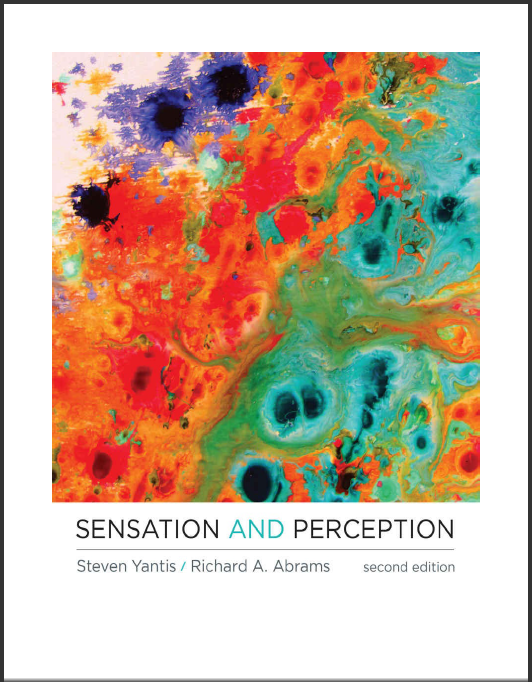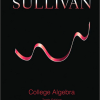Test Bank for Sensation and Perception 2nd Edition by Steven Yantis, Richard Abrams ISBN 9781464154935 1464154937
$70.00 Original price was: $70.00.$35.00Current price is: $35.00.
Instant download (Test Bank) Sensation and Perception 2nd Edition by Steven Yantis after payment
Test Bank for Sensation and Perception 2nd Edition by Steven Yantis, Richard Abrams – Ebook PDF Instant Download/Delivery: 9781464154935 ,1464154937
Full dowload Test Bank for Sensation and Perception 2nd Edition after payment

Product details:
ISBN 10: 1464154937
ISBN 13: 9781464154935
Author: Steven Yantis, Richard Abrams
Like no other text, Sensation and Perception expertly introduces students to how we sense and perceive the world around us. Using clear and detailed explanations and highly effective illustrations the text illuminates the connections between mind, brain, and behavior in the realm of sensation and perception. Seamlessly integrating classic findings with cutting edge research in psychology, physiology and neuroscience Sensation and Perception 2e explores what questions researchers are seeking to answer to today and the methods of investigation they are using. Sensation and Perception, Second Edition, now includes 15 chapters, including separate chapters on motion perception, perception for action, olfaction, and gustation, and a new appendix on noise and signal detection theory The new edition introduces new coauthor Richard A. Abrams (Washington University).
Test Bank for Sensation and Perception 2nd Edition Table of contents:
Chapter 1: Foundations
“I’m Having a Stroke!”
World, Brain, and Mind
The Perceptual Process
Three Main Types of Questions
How Many Senses Are There?
Evolution and Perception
Exploring Perception by Studying Behavior: Psychophysics
Absolute Threshold
Difference Threshold
Psychophysical Scaling
Exploring Perception by Studying Neurons and the Brain
Neurons and Neural Signals
The Human Brain
Cognitive Neuropsychology
Functional Neuroimaging
Applications: Self-Driving Cars
Summary
Key Terms
Expand Your Understanding
Read More About It
Chapter 2: Light and the Eyes
A Rare Case: Vision Without Cones
Light
Light as a Wave
Light as a Stream of Particles
The Optic Array
The Human Eye
Field of View
Acuity and Eye Movements
Structure and Function of the Eye
Photoreceptors: Rods and Cones
Transduction of Light
Number and Distribution of Rods and Cones in the Retina
Adapting to Changes in Lighting
Retinal Ganglion Cells: Circuits in the Retina Send Information to the Brain
Convergence in Retinal Circuits
Receptive Fields
Edge Enhancement: An Example of How It All Works Together
Disorders of the Eye
Strabismus and Amblyopia
Disorders of Accommodation: Myopia, Hyperopia, Presbyopia, and Astigmatism
Cataracts
High Intraocular Pressure: Glaucoma
Floaters and Phosphenes
Retinal Disease: Macular Degeneration and Retinitis Pigmentosa
Applications Night-Vision Devices
Summary
Key Terms
Expand Your Understanding
Read More About It
Chapter 3: The Visual Brain
No Thing to See
From Eye to Brain
Lateral Geniculate Nucleus
Superior Colliculus
Primary Visual Cortex (Area V1)
Response Properties of V1 Neurons
Organization of V1
Functional Areas, Pathways, and Modules
Functional Areas and Pathways
Functional Modules
Applications: Brain Implants for the Blind
Summary
Key Terms
Expand Your Understanding
Read More About It
Chapter 4: Recognizing Visual Objects
Face-Blind
A Few Basic Considerations
Object Familiarity
Image Clutter, Object Variety, and Variable Views
Representation and Recognition
Overview: The Fundamental Steps
Perceptual Organization
Representing Edges and Regions
Figure–Ground Organization: Assigning Border Ownership
Perceptual Grouping: Combining Regions
Perceptual Interpolation: Perceiving What Can’t Be Seen Directly
Perceptual Organization Reflects Natural Constraints
Object Recognition
Hierarchical Processes: Shape Representation in V4 and Beyond
Modular and Distributed Representations: Faces, Places, and Other Categories of Objects
Top-Down Information
The Gist of a Scene
Unconscious Inference and the Bayesian Approach
Applications: Automatic Face Recognition
Feature-Based Approach
Holistic Approach
Summary
Key Terms
Expand Your Understanding
Read More About It
Chapter 5: Perceiving Color
Colorless
Light and Color
Spectral Power Distribution
Spectral Reflectance
Dimensions of Color: Hue, Saturation, and Brightness
Color Circle and Color Solid
Color Mixtures
Color and the Visual System
Trichromatic Color Representation
Opponent Color Representation
Color Contrast and Color Assimilation
Color Constancy
Lightness Constancy
Color Vision Deficiencies
Inherited Deficiencies of Color Vision
Cortical Achromatopsia: Color Blindness from Brain Damage
Applications: Color in Art and Technology
Pointillist Painting
Digital Color Video Displays
Digital Color Printing
Summary
Key Terms
Expand Your Understanding
Read More About It
Chapter 6: Perceiving Depth
Learning to See in 3-D
Oculomotor Depth Cues
Accommodation
Convergence
Monocular Depth Cues
Static Cues: Position, Size, and Lighting in the Retinal Image
Dynamic Cues: Movement in the Retinal Image
Binocular Depth Cue: Disparity in the Retinal Images
Binocular Disparity
Correspondence Problem
Neural Basis of Stereopsis
Integrating Depth Cues
Depth and Perceptual Constancy
Size Constancy and Size–Distance Invariance
Shape Constancy and Shape–Slant Invariance
Illusions of Depth, Size, and Shape
Forced Perspective
Ponzo Illusion
Ames Room
Moon Illusion
Tabletop Illusion
Applications: 3-D Motion Pictures and Television
Summary
Key Terms
Expand Your Understanding
Read More About It
Chapter 7: Perceiving Motion
Still Life
Perceptual Organization from Motion
Perceptual Grouping Based on Real and Apparent Motion
Figure–Ground Organization
Sensitivity to Biological Motion
Eye Movements and the Perception of Motion and Stability
Neural Basis of Motion Perception in Area V1 and Area MT
A Simple Neural Circuit That Responds to Motion
The Motion Aftereffect
Area MT
The Aperture Problem: Perceiving the Motion of Objects
Applications: Visually Induced Motion Sickness
The How and Why of Motion Sickness
Could Artificial Environments Be Made Less Sickening?
Summary
Key Terms
Expand Your Understanding
Read More About It
Chapter 8: Perception for Action
Inaction
Vision Affects Action
Time to Process Visual Feedback
Optic Flow
Prism Adaptation
Action Affects Vision
Action Plans
Action Capabilities
Neural Basis of Perception for Action
The Role of the Parietal Lobe in Eye Movements, Reaching, and Grasping
Bimodal Neurons and Hand-Centered Receptive Fields
Handheld Tool Use
Mirror Neurons
Applications: Perception for Action in Baseball: Catching a Fly Ball and Hitting a Fastball
How to Catch a Fly Ball
How to Hit a Fastball
Summary
Key Terms
Expand Your Understanding
Read More About It
Chapter 9: Attention and Awareness
Out of Mind, Out of Sight
Selective Attention and the Limits of Awareness
Dichotic Listening
Inattentional Blindness
Attentional Blink
Change Blindness
Attention to Locations, Features, and Objects
Attention to Locations
Attention to Features
Attention to Objects
Why Attention Is Selective
The Binding Problem
Competition for Neural Representation
Attentional Control
Top-Down and Bottom-Up Attentional Control
Value-Driven Attentional Control
Sources of Attentional Control in the Brain
Awareness and the Neural Correlates of Consciousness
Seeking the NCCs in Perceptual Bistability
What Blindsight Reveals About Awareness
Applications: Multitasking
Task Switching
Driving While Talking on a Cell Phone
Summary
Key Terms
Expand Your Understanding
Read More About It
Chapter 10: Sound and the Ears
Dizzy
Sound
Sources of Sound
Physical and Perceptual Dimensions of Sound
The Ear
Pinna, Auditory Canal, and Tympanic Membrane
Ossicles and Sound Amplification
Eustachian Tube
Cochlea
Neural Representation of Frequency and Amplitude
Frequency Representation
Amplitude Representation
Disorders of Audition
Hearing Tests and Audiograms
Conductive Hearing Impairments
Sensorineural Hearing Impairments
Tinnitus
Applications: Cochlear Implants
Summary
Key Terms
Expand Your Understanding
Read More About It
Chapter 11: The Auditory Brain and Perceiving Auditory Scenes
Hearing Without Recognition
The Auditory Brain
Ascending Pathways: From the Ear to the Brain
Descending Pathways: From the Brain to the Ear
Auditory Cortex
“What” and “Where” Pathways and Other Specialized Regions of the Auditory Brain
Localizing Sounds
Perceiving Azimuth
Perceiving Elevation
Perceiving Distance
Echolocation by Bats and Humans
Echoes and the Precedence Effect
Looking While Listening: Vision and Sound Localization
Neural Basis of Sound Localization
Auditory Scene Analysis
Simultaneous Grouping
Sequential Grouping
Perceptual Completion of Occluded Sounds
Applications: Seeing by Hearing
Summary
Key Terms
Expand Your Understanding
Read More About It
Chapter 12: Perceiving Speech and Music
“Singing Sounds Like Shouting to Me”
Speech
The Sounds of Speech: Phonemes
Producing the Sounds of Speech
Perceiving the Sounds of Speech
Brain Pathways for Speech Perception and Production
Music
Dimensions of Music: Pitch, Loudness, Timing, and Timbre
Melody
Scales and Keys; Consonance and Dissonance
Knowledge and Music Perception
Neural Basis of Music Perception
Applications: Speech Perception by Machines
Summary
Key Terms
Expand Your Understanding
Read More About It
Chapter 13: The Body Senses
Watch Yourself!
Tactile Perception: Perceiving Mechanical Stimulation of the Skin
Slow-Adapting Type I (SAI) Mechanoreceptors: Perceiving Pattern, Texture, and Shape
Fast-Adapting Type I (FAI) Mechanoreceptors: Perceiving Slip and Maintaining Grip Control
Slow-Adapting Type II (SAII) Mechanoreceptors: Perceiving Skin Stretch and Hand Conformation
Fast-Adapting Type II (FAII) Mechanoreceptors: Perceiving Fine Textures Through Transmitted Vibration
Perceiving Pleasant Touch
Mechanoreceptor Transduction
Proprioception: Perceiving Position and Movement of the Limbs
Perceiving Pain
Thermoreception: Perceiving Temperature
Between Body and Brain
Somatotopic Cortical Maps
Responses and Representations in the Somatosensory Cortex and Beyond
Top-Down Mechanisms of Pain Reduction
Cortical Plasticity, Phantom Limbs, and Rubber Hands
Haptic Perception: Recognizing Objects by Touch
The Vestibular System: Perceiving Balance and Acceleration
Applications: Haptic Feedback in Robot-Assisted Surgery
Summary
Key Terms
Expand Your Understanding
Read More About It
Chapter 14: Olfaction: Perceiving Odors
When the Nose Knows Nothing
What Is an Odor?
Odorants
Detection and Identification of Odors
Detection Thresholds and Difference Thresholds
Identifying and Discriminating Odors
The Role of Odors in Sensing Flavor
Olfactory Impairments: Age and Other Factors
Adaptation to Odors
Anatomical and Neural Basis of Odor Perception
The Olfactory System: From Nose to Brain
Neural Code for Odor
Representing Odors in the Brain
Odors, Emotion, and Memory
Effects of Odors on Social and Reproductive Behavior
Pheromones, Sweat, and Tears
Human Leukocyte Antigen Detection
Applications: The eNose
How eNoses Work
eNoses on Wheels
Summary
Key Terms
Expand Your Understanding
Read More About It
Chapter 15: Gustation: Perceiving Tastes and Flavors
Poor Taste
What Is Taste? What Is Flavor?
Tastants and the Basic Tastes
The Perception of Flavor
Anatomical and Neural Basis of Taste and Flavor Perception
Taste Buds and Taste Receptor Cells
From Taste Buds to the Brain
Representing Taste and Flavor in the Brain
Adaptation and Cross-Adaptation
Cognitive Influences in the OFC, and the Flavor of Expensive Wine
Regulating Food Intake
Sensory-Specific Satiety
Regulating Food Intake in the Absence of Taste
Individual Differences in Taste and Flavor Perception
Applications: How Sweet It Is? The Taste and Use of Artificial Sweeteners
Brain Responses to Artificial Sweeteners
Behavioral Responses to Artificial Sweeteners
Artificial Sweeteners and Weight Loss
Summary
Key Terms
Expand Your Understanding
Read More About It
Appendix: Noise and Signal Detection Theory
Noise in Neural Activity and the Psychometric Function
Signal Detection Theory
A Signal Detection Experiment
Sensitivity and Bias
Applications: Optimal Decision Making in the Real World
Summary
Key Terms
Expand Your Understanding
Read More About It
Glossary
References
Name Index
People also search for Test Bank for Sensation and Perception 2nd Edition :
sensation and perception steven yantis pdf
sensation and perception 2nd edition pdf
sensation and perception 2nd edition pdf free
sensation and perception 2nd edition


